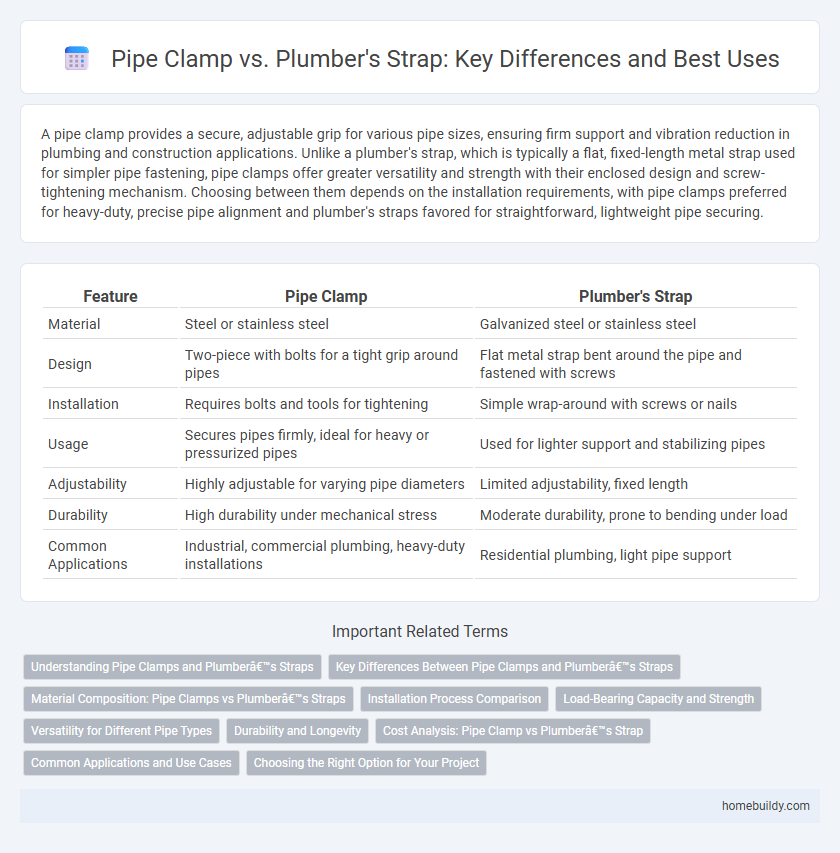A pipe clamp provides a secure, adjustable grip for various pipe sizes, ensuring firm support and vibration reduction in plumbing and construction applications. Unlike a plumber's strap, which is typically a flat, fixed-length metal strap used for simpler pipe fastening, pipe clamps offer greater versatility and strength with their enclosed design and screw-tightening mechanism. Choosing between them depends on the installation requirements, with pipe clamps preferred for heavy-duty, precise pipe alignment and plumber's straps favored for straightforward, lightweight pipe securing.
Table of Comparison
| Feature | Pipe Clamp | Plumber's Strap |
|---|---|---|
| Material | Steel or stainless steel | Galvanized steel or stainless steel |
| Design | Two-piece with bolts for a tight grip around pipes | Flat metal strap bent around the pipe and fastened with screws |
| Installation | Requires bolts and tools for tightening | Simple wrap-around with screws or nails |
| Usage | Secures pipes firmly, ideal for heavy or pressurized pipes | Used for lighter support and stabilizing pipes |
| Adjustability | Highly adjustable for varying pipe diameters | Limited adjustability, fixed length |
| Durability | High durability under mechanical stress | Moderate durability, prone to bending under load |
| Common Applications | Industrial, commercial plumbing, heavy-duty installations | Residential plumbing, light pipe support |
Understanding Pipe Clamps and Plumber’s Straps
Pipe clamps secure piping by encircling the pipe with a metal band and tightening it to provide firm support, ideal for preventing movement and vibration. Plumber's straps are U-shaped metal bands designed to fasten pipes directly to structural surfaces, offering a simpler and more flexible solution for pipe installation. Understanding the differences helps in selecting the appropriate hardware based on pipe size, load requirements, and installation environment.
Key Differences Between Pipe Clamps and Plumber’s Straps
Pipe clamps provide a secure, adjustable grip around pipes using a screw-tightened mechanism, ensuring stability and support during installation or repair. Plumber's straps are simpler metal bands with fixed holes for mounting, primarily designed to hold pipes in place against walls or structures without adjustment capabilities. The key difference lies in the flexibility and grip strength, where pipe clamps allow precise tightening while plumber's straps offer a more rigid, fixed support option.
Material Composition: Pipe Clamps vs Plumber’s Straps
Pipe clamps are typically made from galvanized steel or stainless steel, offering high strength and corrosion resistance suitable for heavy-duty applications. Plumber's straps are often manufactured from flexible steel or plastic materials, providing easier installation around pipes but with less structural rigidity. The material composition directly influences durability and application, with pipe clamps preferred for secure fastening in demanding environments, while plumber's straps favor quick fixes and lightweight support.
Installation Process Comparison
Pipe clamps offer a quick installation process using screws or bolts to secure pipes, requiring minimal tools and adjustments. Plumber's straps typically involve wrapping metal bands around pipes and fastening with screws, which can take longer and may require more precise alignment. Overall, pipe clamps provide a more streamlined and efficient installation compared to the sometimes cumbersome process of plumber's straps.
Load-Bearing Capacity and Strength
Pipe clamps offer superior load-bearing capacity compared to plumber's straps due to their robust construction and ability to securely encircle pipes, distributing weight evenly. Plumber's straps, typically made from flat metal bands, provide less strength and are better suited for light-duty applications where minimal support is required. For heavy pipe installations or systems under significant stress, pipe clamps ensure greater stability and durability.
Versatility for Different Pipe Types
Pipe clamps offer greater versatility for securing various pipe materials, including metal, plastic, and copper, due to their adjustable design and strong grip. Plumber's straps, typically made of metal or plastic strips, provide a simpler fastening solution but may lack adaptability for irregular pipe shapes or sizes. The choice depends on the need for flexibility in installation and the specific pipe types involved in the plumbing project.
Durability and Longevity
Pipe clamps typically offer superior durability and longevity compared to plumber's straps due to their robust metal construction and secure fastening design that resists loosening over time. The rigidity of pipe clamps provides enhanced stability for heavier plumbing installations, reducing wear from vibrations and external forces. Plumber's straps, generally made from thinner metal, may corrode or bend more easily, making them less reliable for long-term use in demanding environments.
Cost Analysis: Pipe Clamp vs Plumber’s Strap
Pipe clamps typically offer a more cost-effective solution for securing pipes due to their lower material and manufacturing expenses compared to plumber's straps. Plumber's straps often require additional installation time and hardware, increasing overall project costs despite their flexibility in various pipe sizes. Evaluating factors like durability, installation efficiency, and material compatibility helps determine the optimal choice for budget-conscious plumbing projects.
Common Applications and Use Cases
Pipe clamps are primarily used for securing pipes in plumbing, HVAC, and industrial installations, providing stable support and minimizing vibration. Plumber's straps are generally more versatile for fastening pipes to walls, ceilings, or studs in residential and commercial environments due to their simple design and ease of installation. Both tools serve to maintain pipe alignment and prevent movement, but pipe clamps offer a more secure grip for heavy-duty or pressurized piping systems.
Choosing the Right Option for Your Project
Pipe clamps provide secure, adjustable support for pipes, ideal for applications requiring frequent modifications or maintenance. Plumber's straps offer a simpler, fixed solution, best suited for permanent installations where cost-effectiveness and straightforward mounting are priorities. Selecting between a pipe clamp and plumber's strap depends on the need for flexibility, load capacity, and the specific environmental conditions of your plumbing project.
Pipe clamp vs Plumber’s strap Infographic

 homebuildy.com
homebuildy.com